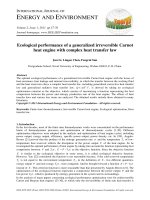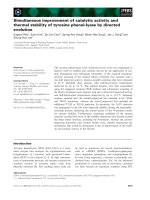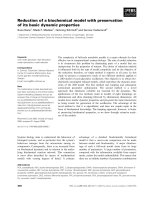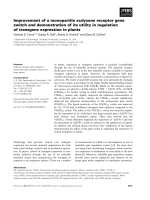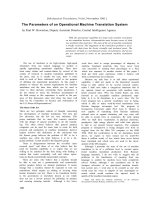Dynamic stability improvement of a multi machine power system connected with a large scale offshore wind farm using a generalized inified power flow controller (tt)
Bạn đang xem bản rút gọn của tài liệu. Xem và tải ngay bản đầy đủ của tài liệu tại đây (6.54 MB, 17 trang )
National Cheng Kung University
Department of Electrical Engineering
Tainan City, Taiwan, R. O. C.
Master of Science Thesis
Dynamic-Stability Improvement of a
Multi-machine Power System connected
with a Large-scale Offshore Wind Farm
Using a Generalized Unified Power Flow
Controller
Student:
Advisor:
Nguyen Thi Ha
Li Wang
July 2014
Dynamic-Stability Improvement of a Multi-machine
Power System connected with a Large-scale Offshore
Wind Farm Using a Generalized Unified Power Flow
Controller
Nguyen Thi Ha* and Li Wang**
Department of Electrical Engineering
National Cheng Kung University
Tainan City, Taiwan, R. O. C.
Abstract
This thesis studies the dynamic-stability improvement of a multi-machine system
connected with a large-scale offshore wind farm based on doubly-fed induction
generator (DFIG) using a generalized unified power-flow controller (GUPFC). A twoarea four-generator system model is employed as the studied multi-machine system.
Two proportional-integral-derivative (PID) damping controllers and two fuzzy logic
controllers (FLCs) of the proposed GUPFC are respectively designed to improve the
stability of the studied multi-machine power system connected with the offshore wind
farm under different operating conditions.
A frequency-domain approach based on a linearized system model using
eigenvalue analysis and a time-domain method based on nonlinear-model simulations
subject to various disturbances are both performed to examine the effectiveness of the
proposed GUPFC combined with the designed damping controllers.
It can be concluded from the comparative simulation results that the proposed
GUPFC joined with the designed FLCs demonstrates better damping performance for
improving the stability of the studied multi-machine system subject to different
disturbances than the designed PID damping controllers.
Keywords: Multi-machine system, wind farm, doubly-fed induction generator,
generalized unified power-flow controller, dynamic stability, flexible
AC transmission systems.
* The student
** The advisor
I
ACKNOWLEDGEMENTS
First of all, I would like to express my deep gratitude to my advisor Professor Li
Wang for his help, his advice and his teaching. His valuable suggestions, his
encouragement and his patience have been a big help for me over the last time.
I am very grateful to all Professors in Power Group of Electrical Engineering
Department, National Cheng Kung University (NCKU) as well as Professors from other
Universities for their teaching, encouragement, and valuable comments.
I also would like to thank my colleagues at the laboratory for the enjoyable
discussions and friendly atmosphere.
Furthermore, I would like to extend my deepest gratitude and personal thanks to
those closest to me. In particular, I would like to thank my families for their support,
encouragement and understanding.
Last but not least, I would like to say special thanks to the NCKU Scholarship
Program for giving me the opportunity to work on a highly studying environment and
for their financial support.
Nguyen Thi Ha
II
LIST OF CONTENTS
Abstract.............................................................................................................................. I
Acknowledgements .......................................................................................................... II
List of contents ............................................................................................................... III
List of figures ................................................................................................................. VI
List of tables .....................................................................................................................X
Nomenclature................................................................................................................. XII
List of symbols ............................................................................................................ XIV
Chapter 1. Introduction ................................................................................................. 1
1.1. Motivation ............................................................................................................. 1
1.2. Literature review ................................................................................................... 3
1.2.1. Topics of DFIG-based OWFs ................................................................... 3
1.2.2. Topics of GUPFC ...................................................................................... 5
1.3. Contribution of the thesis ...................................................................................... 5
1.4. Outline of the thesis .............................................................................................. 6
Chapter 2. Configuration of the system ....................................................................... 7
2.1. Configuration of the system .................................................................................. 7
2.2. Two-area four-generator system and its subsystems ............................................ 8
2.2.1. Synchronous generator model ................................................................... 9
2.2.2. Excitation system model ......................................................................... 10
2.2.3. Steam-turbine and speed-governor models ............................................. 12
2.3. Modeling of DFIG-based wind turbine system .................................................. 15
2.3.1. Configuration of DFIG-based wind turbine system ................................ 15
2.3.2. Wind speed model ................................................................................... 15
2.3.3. Wind turbine model ................................................................................. 17
III
2.3.4. Mass-Spring-Damper Model ................................................................... 18
2.3.5. Doubly-fed induction generator model ................................................... 18
2.3.6. Back-to-back converter model ................................................................ 20
2.3.7. RSC controller ......................................................................................... 21
2.3.8. GSC controller......................................................................................... 22
2.3.9. Pitch angle controller............................................................................... 24
2.4. GUPFC model..................................................................................................... 25
2.4.1. Mathematical model of a GUPFC ........................................................... 25
2.4.2. GUPFC power flow controller ................................................................ 28
2.5. Network equations .............................................................................................. 30
Chapter 3. Design of oscillation damping controllers for GUPFC .......................... 33
3.1. Design of two PID controllers for GUPFC ......................................................... 33
3.2. Analysis of closed-loop system eigenvalue sensitivities .................................... 40
3.3. Design of two FLC controllers for GUPFC ........................................................ 45
Chapter 4. Steady-state analysis of the system under various
operating conditions .................................................................................... 49
4.1. Power flow calculation under the steady-state condition of the system ............. 49
4.2. Different operating active power conditions of SGs .......................................... 50
4.3. Various terminal voltages of SGs ....................................................................... 69
4.4. Different wind-speed conditions ......................................................................... 85
4.5. Various operating terminal voltages of DFIG .................................................... 98
Chapter 5. Time-domain simulations ....................................................................... 104
5.1. Disturbance on input mechanical torques of SGs ............................................. 104
5.2. Three-phase short-circuit fault at transmission line without changing
network structure ............................................................................................. 113
5.3. Three-phase short-circuit fault at transmission line with changing network
structure ............................................................................................................ 121
IV
5.4. Wind-speed variations ...................................................................................... 129
Chapter 6. Conclusion and future work ................................................................... 136
6.1. Conclusion ........................................................................................................ 136
6.2. Future work ....................................................................................................... 137
References .................................................................................................................... 138
Appendix ...................................................................................................................... 143
Biography ..................................................................................................................... 146
Publication lists ............................................................................................................ 147
V
LIST OF FIGURES
Fig. 2.1
Configuration of the system......................................................................... 8
Fig. 2.2
Single-line diagram of the studied two-area four-generator system............ 9
Fig. 2.3
Block diagram of the two-axis model of the SG ....................................... 10
Fig. 2.4
Block diagram of the IEEE type I excitation system ................................. 11
Fig. 2.5
Single-reheat tandem-compound steam turbine model ............................. 13
Fig. 2.6
Speed-governor model for steam turbine .................................................. 14
Fig. 2.7
One-line diagram of wind DFIG driven by a VSWT through a GB ......... 15
Fig. 2.8
Simplified reduced-order two-mass model of WT drive train................... 18
Fig. 2.9
DFIG dq-axis equivalent circuit ................................................................ 19
Fig. 2.10
Model of back-to-back converter............................................................... 20
Fig. 2.11
Control block diagram of the RSC controller ............................................ 22
Fig. 2.12
Stator-flux-oriented reference frame ......................................................... 22
Fig. 2.13
Control block diagram of the GSC controller............................................ 23
Fig. 2.14
Stator-voltage-oriented reference frame .................................................... 24
Fig. 2.15
Control block diagram of pitch angle controller........................................ 24
Fig. 2.16
Operation principle of the GUPFC with three converters ......................... 26
Fig. 2.17
The equivalent circuit of the GUPFC ........................................................ 26
Fig. 2.18
Control block diagram of GUPFC ............................................................. 29
Fig. 2.19
Integration of models into the system ........................................................ 31
Fig. 2.20
Transformation from the i-th generator
to
the common D-Q reference frame ............................................................. 32
VI
Fig. 3.1
The control block diagram of the phase angle
of the GUPFC
including PID controllers ......................................................................... 34
Fig. 3.2
Fuzzy logic controller structure ................................................................. 45
Fig. 3.3
The control block diagram of the phase angle
of the GUPFC
including FLCs .......................................................................................... 47
Fig. 3.4
Membership functions for the two proposed FLCs. .................................. 48
Fig. 4.1
The configuration of system without GUPFC ........................................... 52
Fig. 4.2
The configuration of system with GUPFC ................................................ 52
Fig. 4.3
Power flow of the system under different active powers
of SG2. ....................................................................................................... 58
Fig. 4.4
Power flow of the system under different active powers
of SG3. ....................................................................................................... 63
Fig. 4.5
Power flow of the system under different active powers
of SG4. ....................................................................................................... 68
Fig. 4.6
Power flow of the system without and with GUPFC
under different terminal voltages of SG2. ................................................. 74
Fig. 4.7
Power flow of the system without and with GUPFC
under different terminal voltages of SG3. ................................................. 79
Fig. 4.8
Power flow of the system without and with GUPFC
under different terminal voltages of SG4. ................................................. 84
Fig. 4.9
Root locus of oscillatory modes under different wind speed
conditions. ................................................................................................. 96
Fig. 4.10
Power flow of the system without and with GUPFC
under different terminal voltages of DFIG .............................................. 103
Fig. 5.1
Sequence of the applied torque disturbances of SGs ............................... 106
Fig. 5.2
Dynamic responses of the system subject to torque
disturbances on SGs input mechanical torques without
VII
and with GUPFC .................................................................................... 106
Fig. 5.3
Dynamic responses of the system subject to torque
disturbances on SGs input mechanical torques with
GUPFC and with GUPFC+PIDs ............................................................. 109
Fig. 5.4
Dynamic responses of the system subject to torque
disturbances on SGs input mechanical torques with
GUPFC+PIDs and with GUPFC+FLCs .................................................. 111
Fig. 5.5
Transient responses of the system subject to a
three-phase short-circuit fault at one of parallel
transmission line 10-11 without changing network
structure without and with GUPFC ......................................................... 114
Fig. 5.6
Transient responses of the system subject to a
three-phase short-circuit fault at one of parallel
transmission line 10-11 without changing network
structure with GUPFC and with GUPFC+PIDs ...................................... 117
Fig. 5.7
Transient responses of the system subject to a
three-phase short-circuit fault at one of parallel
transmission line 10-11 without changing
network structure with GUPFC+PIDs and with GUPFC+FLCs ............. 119
Fig. 5.8
Transient responses of the system subject to a
three-phase short-circuit fault at one of parallel
transmission line 10-11 with changing network
structure without and with GUPFC ......................................................... 122
Fig. 5.9
Transient responses of the system subject to a
three-phase short-circuit fault at one of parallel
transmission line 10-11 with changing network
structure with GUPFC and with GUPFC+PIDs ...................................... 125
VIII
Fig. 5.10
Transient responses of the system subject to a three-phase short-circuit
fault at one of parallel transmission line 10-11 with changing
network structure with GUPFC+PIDs and with GUPFC+FLCs ............. 127
Fig. 5.11
Wind-speed variations ............................................................................. 129
Fig. 5.12
Dynamic responses of the system under the variations
of wind speed without and with GUPFC ................................................. 130
Fig. 5.13
Dynamic responses of the system under the variations
of wind speed with GUPFC and with GUPFC+PIDs .............................. 132
Fig. 5.14
Dynamic responses of the system under the variations
of wind speed with GUPFC+PIDs and with GUPFC+FLCs ................... 134
IX
LIST OF TABLES
Table 3.1
Eigenvalues (rad/s) of the system without GUPFC, with
GUPFC, and with GUPFC and the designed PIDs.................................... 37
Table 3.2
RSCs of the closed-loop system eigenvalues with respect
to the two designed PID
....................................................... 41
Table 3.3
Control rules of the studied FLCs .............................................................. 48
Table 4.1
Power flow calculation of the system without GUPFC ............................. 51
Table 4.2
Power flow calculation of the system with GUPFC .................................. 51
Table 4.3
Steady-state operating points of the system without
and with GUPFC under different active powers of SG2 .......................... 54
Table 4.4
Steady-state operating points of the system without
and with GUPFC under different active powers of SG3 ........................... 59
Table 4.5
Steady-state operating points of the system without
and with GUPFC under different active powers of SG4 .......................... 64
Table 4.6
Steady-state operating points of the system without
and with GUPFC under different terminal voltages of SG2 .................... 70
Table 4.7
Steady-state operating points of the system without
and with GUPFC under different terminal voltages of SG3 .................... 75
Table 4.8
Steady-state operating points of the system without
and with GUPFC under different terminal voltages of SG4 .................... 80
Table 4.9
Eigenvalues (rad/s) of the studied system without GUPFC
under different wind speeds ...................................................................... 87
Table 4.10 Eigenvalues (rad/s) of the system with GUPFC
under different wind speeds...................................................................... 91
X
Table 4.11 Steady-state operating points of the system without and
with GUPFC under different operating voltages of DFIG ......................... 99
Table A.1
Employed system parameters for four-machine system .......................... 143
Table A.2
Employed system parameters for transmission line. ............................... 144
Table A.3
Employed system parameters for DFIG-based OWF .............................. 144
Table A.4
Employed constants for power coefficients of WT ................................. 145
Table A.5
Employed system parameters for GUPFC ............................................... 145
XI
NOMENCLATURE
CV
Control valve
DFI
Defuzzier interface
DFIG
Doubly-fed induction generator
DML
Decision-making logic
EMTP
Electromagnetic transients program
FACTS
Flexible AC transmission systems
FLC
Fuzzy logic controller
GUPFC
Generalized
GB
Gearbox
GSC
Grid-side converter
HP
High-pressure turbine
IGBT
Insulated gate bipolar transistor
IP
Intermediate-pressure turbine
IPFC
Interline power-flow controller
IV
Intercept valve
KB
Knowledge base
LP
Low-pressure turbine
ODC
Oscillation damping controller
OMIB
One-machine infinite-bus
OWF
Offshore wind farm
PID
Proportional integral derivative
PMSG
Permanent-magnet synchronous generators
PWM
Pulse-width modulation
RMS
Root mean square
XII
RSC
Rotor-side converter
SG
Synchronous generator
SSSC
Static synchronous series compensator
UPFC
VSC
Voltage source converter
VSWT
Variable-speed wind turbine
TQD
Torque disturbance
WT
Wind turbine
WECS
Wind energy conversion system
XIII
LIST OF SYMBOLS
Mechanical torque of SG
Electromagnetic torque of SG
Field winding voltage of SG
Exciter output voltage
Rotor angle of SG (deg.)
Eigenvalues (rad/s)
-
Intermediate variables used in subsystems model of SG
Wind speed
Power coefficient of WT
Tip speed ratio of WT
Pitch angle of WT
Mechanical power of WT
Mechanical torque of WT
Stator (terminal) voltage of DFIG
Stator current of DFIG
Stator active power of DFIG
Stator reactive power of DFIG
Rotor voltage of DFIG
Rotor current of DFIG
Rotor active power of DFIG
XIV
Rotor reactive power of DFIG
Grid-side converter voltage of DFIG
I gw
Grid-side converter current of DFIG
Grid-side converter active power of DFIG
gw
Grid-side converter reactive power of DFIG
Total active power of DFIG
Total reactive power of DFIG
Electromagnetic torque of DFIG
Rotational speed of WT
Shaft twist angle of WT-DFIG
Rotor speed of DFIG
Rotor slip of DFIG
DC-link voltage between RSC and GSC of DFIG
-
Intermediate variables used in controller model of DFIG
Series injected voltage by GUPFC
Shunt injected voltage by GUPFC
Phase angle of series injected voltage by GUPFC
Phase angle of shunt injected voltage by GUPFC
DC-capacitor voltage of GUPFC
Base angular frequency
Synchronous speed (
pu)
Gains of PID damping controller
XV
Washout-term time constant of PID damping controller (s)
The number of pole pairs
The dot notation is used to signify derivatives with respect to time t, for example,
XVI

